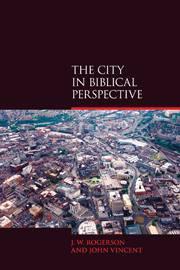Book contents
- Frontmatter
- Contents
- Preface
- Part 1 The city in the Old Testament
- Introduction
- Chapter 1 The Israelite City: History and Archaeology
- Chapter 2 The Israelite City: Biblical Perspectives
- Chapter 3 Making Connections
- Bibliography
- Part 2 The City in the New Testament
- Epilogue
- Bibliography
- Index of Biblical References
- Author Index
- Subject Index
Chapter 1 - The Israelite City: History and Archaeology
from Part 1 - The city in the Old Testament
- Frontmatter
- Contents
- Preface
- Part 1 The city in the Old Testament
- Introduction
- Chapter 1 The Israelite City: History and Archaeology
- Chapter 2 The Israelite City: Biblical Perspectives
- Chapter 3 Making Connections
- Bibliography
- Part 2 The City in the New Testament
- Epilogue
- Bibliography
- Index of Biblical References
- Author Index
- Subject Index
Summary
The Israelites did not invent cities and city life; they took over institutions that had existed for at least two thousand years before the heyday of Israelite cities (c. 925–720 BCE). The distinctively Israelite contribution was the prophetically-derived critique of cities and city life based upon belief in a God of justice. Urbanization in ancient Palestine began around 3000 BCE, with settlements such as Jericho and Megiddo which were characterized by large public buildings, including temples (see generally Fritz, 1990: 15–38). The urbanization process reached its peak around 2650–2350, and then underwent a decline, with many cities disappearing by around 2000. The causes are unknown. They could have included a decrease in rainfall, and a lowering of water tables, and inter-city rivalry and warfare. A second phase of urban expansion and subsequent decline took place in the period 1800–1200 BCE.
Israelite cities took over and rebuilt existing cities. This is true, apparently, even of Samaria, where the Bible gives the impression that it was a completely new foundation built on the initiative of the Israelite king Omri (see 1 Kgs 16:24; de Geus, 2003: 43). The striking thing about the Israelite cities is how much smaller they were than the most important centres of population in the ancient Near East. Also, some Israelite cities, such as Hazor, occupied only a small part of the site that had made up the preceding Canaanite city. Tables 1.1 and 1.2 give some idea of the size of Israelite cities compared with other settlements.
- Type
- Chapter
- Information
- The City in Biblical Perspective , pp. 5 - 20Publisher: Acumen PublishingPrint publication year: 2009



